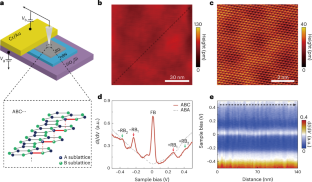斜方多层石墨烯电子结构和相关性的层依赖性演化
IF 38.1
1区 材料科学
Q1 MATERIALS SCIENCE, MULTIDISCIPLINARY
引用次数: 0
摘要
最近在三层斜方体石墨烯(RG)中发现的超导性和磁性为研究强相关电子现象提供了一个理想的非扭曲平台。然而,多层 RG 中的相关效应受到的关注有限,尤其是相关性随层数增加而演变的问题仍未解决。在这里,我们利用扫描隧道显微镜和光谱学,在令人惊讶的液氮温度下,观察到了 3 至 9 层 RG 多层中与层相关的电子结构和相关性。我们明确确定了层增强的低能平带和层间耦合强度。前者直接表明了较厚 RG 中低能平坦带的进一步平坦化,后者表明了 RG 多层中存在不同的层间相互作用。此外,我们还发现,在 77 K 时,当平坦带被部分填充时,会出现明显的分裂,范围从 ~50 meV 到 80 meV 不等,这表明出现了相互作用引起的强相关态。特别是,相关态的强度在较厚的 RG 中明显增强,并在六层 RG 中达到最大值,直接验证了理论预测,并为强相关系统建立了丰富的新候选。我们的研究结果为了解 RG 中电子特性的层依赖性提供了宝贵的见解,并证明 RG 是研究稳健、高可及相关相的合适体系。本文章由计算机程序翻译,如有差异,请以英文原文为准。


Layer-dependent evolution of electronic structures and correlations in rhombohedral multilayer graphene
The recent discovery of superconductivity and magnetism in trilayer rhombohedral graphene (RG) establishes an ideal, untwisted platform to study strong correlation electronic phenomena. However, the correlated effects in multilayer RG have received limited attention, and, particularly, the evolution of the correlations with increasing layer number remains an unresolved question. Here we show the observation of layer-dependent electronic structures and correlations—under surprising liquid nitrogen temperature—in RG multilayers from 3 to 9 layers by using scanning tunnelling microscopy and spectroscopy. We explicitly determine layer-enhanced low-energy flat bands and interlayer coupling strengths. The former directly demonstrates the further flattening of low-energy bands in thicker RG, and the latter indicates the presence of varying interlayer interactions in RG multilayers. Moreover, we find significant splittings of the flat bands, ranging from ~50 meV to 80 meV, at 77 K when they are partially filled, indicating the emergence of interaction-induced strongly correlated states. Particularly, the strength of the correlated states is notably enhanced in thicker RG and reaches its maximum in the six-layer, validating directly theoretical predictions and establishing abundant new candidates for strongly correlated systems. Our results provide valuable insights into the layer dependence of the electronic properties in RG and demonstrate it as a suitable system for investigating robust and highly accessible correlated phases. By using scanning tunnelling microscopy and spectroscopy, researchers observe layer-dependent electronic correlations in rhombohedral graphene multilayers at 77 K, revealing the layer-enhanced low-energy flat bands and interlayer interactions.
求助全文
通过发布文献求助,成功后即可免费获取论文全文。
去求助
来源期刊

Nature nanotechnology
工程技术-材料科学:综合
CiteScore
59.70
自引率
0.80%
发文量
196
审稿时长
4-8 weeks
期刊介绍:
Nature Nanotechnology is a prestigious journal that publishes high-quality papers in various areas of nanoscience and nanotechnology. The journal focuses on the design, characterization, and production of structures, devices, and systems that manipulate and control materials at atomic, molecular, and macromolecular scales. It encompasses both bottom-up and top-down approaches, as well as their combinations.
Furthermore, Nature Nanotechnology fosters the exchange of ideas among researchers from diverse disciplines such as chemistry, physics, material science, biomedical research, engineering, and more. It promotes collaboration at the forefront of this multidisciplinary field. The journal covers a wide range of topics, from fundamental research in physics, chemistry, and biology, including computational work and simulations, to the development of innovative devices and technologies for various industrial sectors such as information technology, medicine, manufacturing, high-performance materials, energy, and environmental technologies. It includes coverage of organic, inorganic, and hybrid materials.
 求助内容:
求助内容: 应助结果提醒方式:
应助结果提醒方式:


